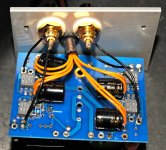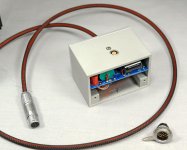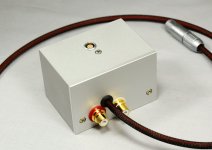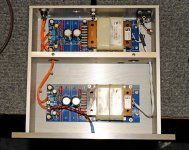Carl,
You can build a different type of power supply ~ +/- 15v.
On the caps, I think there are plenty of other choices, not sure how they will affect sound - but the film caps here need to be close to spec for the RIAA to work right.
You can build a different type of power supply ~ +/- 15v.
On the caps, I think there are plenty of other choices, not sure how they will affect sound - but the film caps here need to be close to spec for the RIAA to work right.
For el cheapo version, check the phonoclone thread: http://www.diyaudio.com/forums/analogue-source/57398-phonoclone-vsps-pcb-help-desk.html
It is similar circuit, although not exactly the same, however, parts substitutions should work here equally well.
It is similar circuit, although not exactly the same, however, parts substitutions should work here equally well.
I just noticed that Nichicon Muse is not on this list. Are Silmics preferred?
I don't know, din't try any of them 😉
As far as cheapo parts for the build, go ahead and use WIMA MKSs and carbon comps. The sound will be different, but it will still sound "good." I wouldn't be surprised to find cheapo parts in the product that inspired this all. 😀 Tip: I once laid this circuit out with SMD resistors and WIMA MKS2s with 2.5mm pitch, to get the shortest feedback loops, and the results were also very impressive. Much faster, tighter, preciser and dynamic, if lacking in the clarity and detail of the boutique build. So, please, experiment, and report back.
Interesting observation. I changed the input signal wire from 26 awg mundory silver/gold to 24 awg neotech legenburg UPOCC copper with exactly those results:
Faster, tighter, more precise and much more dynamic. Also an improvement in depth of soundstage. It lacks the detail of the silver/gold, but sounds *so* much better -- there is no contest.
Faster, tighter, more precise and much more dynamic. Also an improvement in depth of soundstage. It lacks the detail of the silver/gold, but sounds *so* much better -- there is no contest.
So...due to having to replace one of the op-amps in my phono stage a couple times, and making a bit of a mess of it (desoldering is NOT one of my skills), I decided to rebuild the phono using a new PCB which peter kindly provided me.
Anyway, in the meantime I have had a system change. I went from the Harbeth SHL5 to a 'three-way' horn system using a JBL E145 in a 4560 cabinet, a 2420 compression driver in a 511b horn, and a JBL 2405H slot tweeter, bi-amped with xindak monoblocks for bass and a 45 based SET amp for the mids/highs.
The point is, my speakers went from not-so-sensitive 86dB, to an extremely sensitive +105dB...
Now I have completed the phono stage yesterday and it seems as if I have WAY too much gain, and I am hearing a lot of hiss from the phono stage. I thought it may have been solder flux or something and so I cleaned it with isopropyl to no effect...I have the feeeling that I am hearing noise from the op-amps, but I am not sure.
The hissing noise is definitely coming from both channels.
Thanks for any suggestions,
Byron
edit: btw, I bought the op-amps off of ebay (china), and I am wondering if they are really OPA637/627. Could be that they are fakes? Dunno
Anyway, in the meantime I have had a system change. I went from the Harbeth SHL5 to a 'three-way' horn system using a JBL E145 in a 4560 cabinet, a 2420 compression driver in a 511b horn, and a JBL 2405H slot tweeter, bi-amped with xindak monoblocks for bass and a 45 based SET amp for the mids/highs.
The point is, my speakers went from not-so-sensitive 86dB, to an extremely sensitive +105dB...
Now I have completed the phono stage yesterday and it seems as if I have WAY too much gain, and I am hearing a lot of hiss from the phono stage. I thought it may have been solder flux or something and so I cleaned it with isopropyl to no effect...I have the feeeling that I am hearing noise from the op-amps, but I am not sure.
The hissing noise is definitely coming from both channels.
Thanks for any suggestions,
Byron
edit: btw, I bought the op-amps off of ebay (china), and I am wondering if they are really OPA637/627. Could be that they are fakes? Dunno
Last edited:
I am afraid that this circuit is not a "low-noise design." Even with a low-noise PSU and regulators, there will always be a bit of ambient hiss. Because of the way the inner impedance of the cartridge is an active part of the circuit setting the gain of the first stage, the first op-amp "sees" on its Vin+ and Vin- legs (the most sensitive legs of the op amp) quite alot of extension into the HFI and RFI environment through the tone-arm cable. That does not keep the circuit from sounding excellent, but it will never be perfectly quiet, unfortunately, just as a Gainclone is never perfectly quiet, and always has a little low level hum, but for different reasons.
**
My experience with Chinese 627/637s is that there is no problem with noise (as long as they are authentic) but I have noticed some older production code numbers and greater variation in the DC offset sometimes.
**
My experience with Chinese 627/637s is that there is no problem with noise (as long as they are authentic) but I have noticed some older production code numbers and greater variation in the DC offset sometimes.
Tip: always shield this circuit in a metal enclosure with the PSU star ground connected to case. Connect the turntable earth to the grounded phono unit case.
Finally got around to taking a few pictures of the phono stage that Peter put together for me a while back. I had built this circuit in one of the integrated enclosures over a year ago, compared it with a few other phono options in my system and decided that this was the one for me; however, my circuit was not quite as quiet as I would have liked with my Lyra Delos. I asked Peter to rebox it for me in a small enclosure that I could mount right were the interface box is on a VPI table and run the tonearm cable right to the phono circuit. Peter put together a dual mono PS in the integrated enclosure.
Results - phenomenal, can't see myself ever giving this one up, my ears aren't that good to notice an improvement from here!
Thanks Peter!!
Results - phenomenal, can't see myself ever giving this one up, my ears aren't that good to notice an improvement from here!
Thanks Peter!!
An externally hosted image should be here but it was not working when we last tested it.
An externally hosted image should be here but it was not working when we last tested it.
An externally hosted image should be here but it was not working when we last tested it.
Connecting the tone arm cables directly to the INPUT pins of the first OPA without using an intervening RCA cable to join TT and phono-stage is the best way to use this circuit. The currents and voltages involved on the input are so small, that degradation occurs very quickly with RCA sockets, RCA plugs, long cables, etc. Once I removed the RCA plugs between TT and phono-stage, it was as if I moved from row 15 to row 3 of the concert hall.
Sure seems like hum pickup from the TT motor would then increase dramatically. But it sounds like not in your case, slawney? Nor yours 04dgmsilv?
Sure seems like hum pickup from the TT motor would then increase dramatically. But it sounds like not in your case, slawney? Nor yours 04dgmsilv?
None whatsoever, surface noise even from my cleanest albums dominates any remaining noise from this circuit. With the cart off the record, I only get some 'ocean surf' around 2-3 o'clock on the preamp dial, which is insanely loud in my system and some of that is certainly attributed to my tube preamp.
Finally got around to taking a few pictures of the phono stage that Peter put together for me a while back.
It was s tight fit and a bit tricky to assemble, but I'm glad it worked out fine. Here, some more pics of the inside:
Attachments
I don't actually think that it's a problem with the phono stage, because I actually took it over to a friends and tried it as well - same thing...this is not a slight hissing sound, but something you can hear very prominently, even with music playing.
I think I got taken ordering the OpAmps from ebay (china) and have put in a new order for 627AP/637AP from Digikey.
The fact is that I was completely satisfied with the amount of noise before (which truthfully was non-existent IMO)
Byron
I think I got taken ordering the OpAmps from ebay (china) and have put in a new order for 627AP/637AP from Digikey.
The fact is that I was completely satisfied with the amount of noise before (which truthfully was non-existent IMO)
Byron
Hi Peter,
this really compacted version of the phono looks
really nice. Connectors are from lomo right?
Is this an upgraded version? Because in the original
circuit there is one 100uF BG for two opamps each
channel, in the picture i see one BG each op.
Greetings ulf
this really compacted version of the phono looks
really nice. Connectors are from lomo right?
Is this an upgraded version? Because in the original
circuit there is one 100uF BG for two opamps each
channel, in the picture i see one BG each op.
Greetings ulf
Yes, the signal comes through LEMO, PS connected with Neutrik.
The reason we see dual caps is because the circuit uses separate PS for each channel.
BTW, the board was also optimized for dual mono application as explained here: http://www.diyaudio.com/forums/audio-sector/151938-phono-stage-8.html#post2001181
The reason we see dual caps is because the circuit uses separate PS for each channel.
BTW, the board was also optimized for dual mono application as explained here: http://www.diyaudio.com/forums/audio-sector/151938-phono-stage-8.html#post2001181
Attachments
Last edited:
Peter, are those Tx less offensive than EI for hum field in practice? Should project from their core corners for one.
Hi Peter,
looks great, as usual ;-)
BUT i always thought that those high quality constant-current/ shunt
psu´s should be as close to the load as possible... did you do any
measurements or listenings between close to the load and in
different cases?
Greetings ulf
looks great, as usual ;-)
BUT i always thought that those high quality constant-current/ shunt
psu´s should be as close to the load as possible... did you do any
measurements or listenings between close to the load and in
different cases?
Greetings ulf
- Home
- More Vendors...
- Audio Sector
- The Phono Stage





